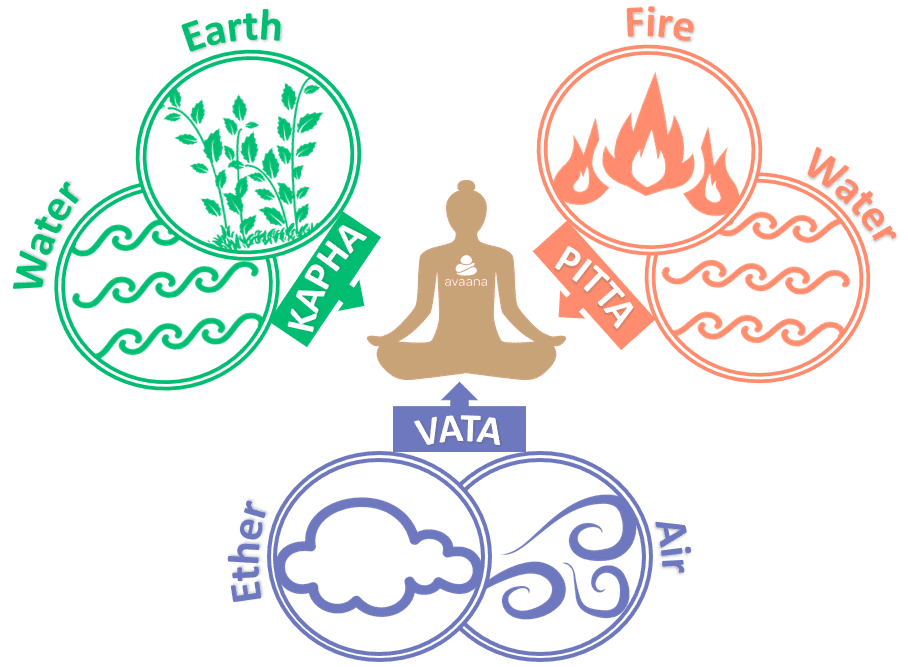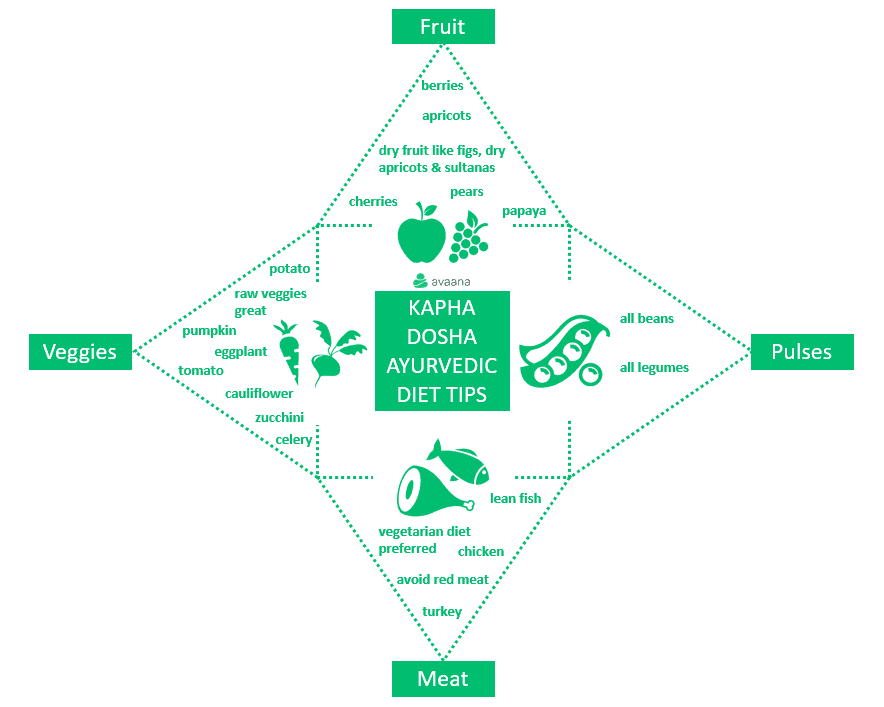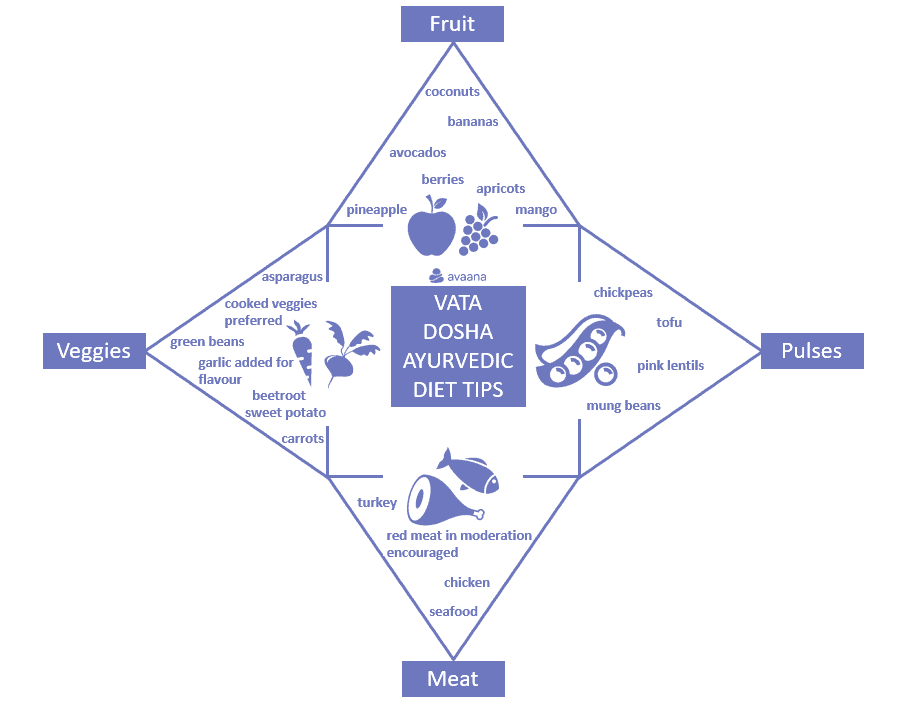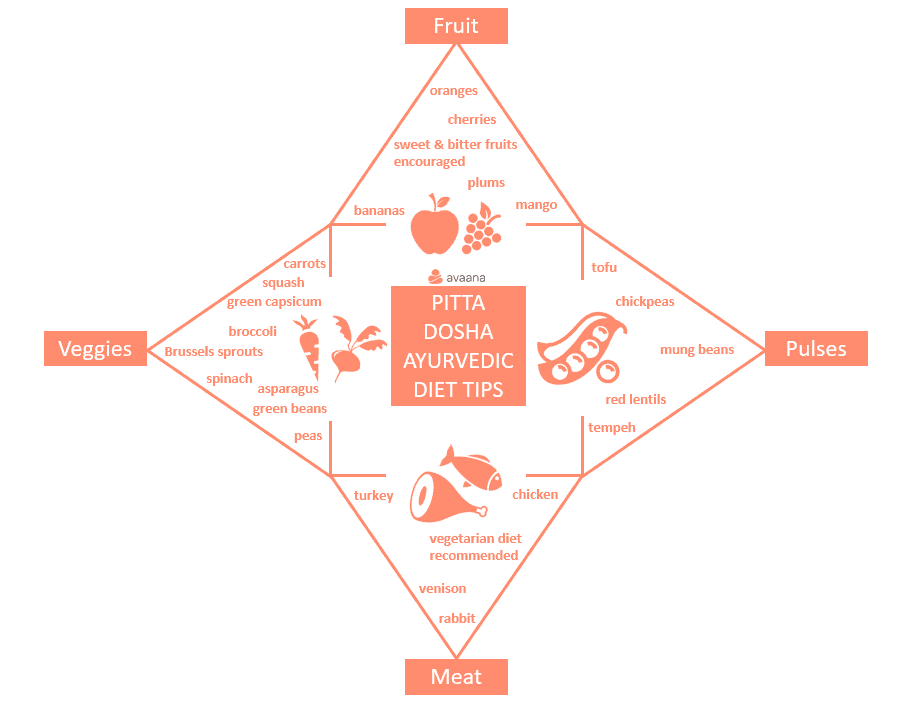No kidding, the traditional medicine of Ayurveda is over 5000 years ago at this point! Hard to comprehend, isn’t it? But with the emerging focus on prevention and mind-body synergy, learning about the different Ayurveda doshas can be extremely useful in helping in finding the best ayurvedic food. Read more to find out how the different dosha types can help you create the ultimate personal Ayurveda diet plan.
‘Sounds good,’ you might be thinking, ‘but –
What is a dosha?
Don’t you worry, because we’ve got you covered!
According to Ayurvedic principles, each individual is born with a combination of three life energies. These are called doshas.
The blend of Kapha, Vata, and Pitta doshas bring your physical and mental characteristics to life.
And the cool part is, each person has a unique combination. Ayurvedic practitioners refer to your unique character traits as Prakriti.
With us so far? Excellent!
An easy way to remember the three life energies is through knowing their affinities. Kaphas are physically and emotionally strong like earth and water. Vatas are charming and quick witted like air and ether. And last but definitely not least, Pittas are intelligent if impatient like fire and water.

When your doshas are in balance, you can enjoy optimal health and wellbeing. In many ways, it’s simple. But keeping everything in balance can be tricky when life gets hectic.
In Ayurveda, imbalances are referred to as Vikruti. You may notice you feel out of sorts if this occurs. However, the symptoms or disease you present with will depend on which dosha is more dominant within your character.
A little confusing to figure out? The good news is, Ayurvedic practitioners are trained to recommend lifestyle changes or an Ayurvedic diet appropriate for your dominant doshas.
Once these recommendations are in place as part of your daily lifestyle, you should find that your health returns to balance and a feeling of wellness will emerge.
Dosha analysis: which type are you?
Dosha types. Shall we talk about them?
Yes, let’s! While we each have varying degrees of each of the Kapha, Vata, and Pitta doshas, one (or sometimes two) will typically present as more dominant.
Being aware of your dosha ‘vulnerabilities’ can allow you to more quickly notice when your health may be struggling. You’ll also be able to better understand what to do to restore harmony to your body.
Without this knowledge or intervention, you may continue to feel unwell and out of balance.
When you are not at peak health, you may feel the following, depending on your dominant dosha types:
- Kaphas may feel lethargic, depressed, or have sluggish digestion. They may also experience fluid retention or experience weight gain.
- Vatas may suffer from insomnia, anxiety, or feel isolated. They may also experience decreased mental acuity or feelings of insecurity.
- Pittas may present with nausea, acne, or inflammatory disorders. They may also feel frustrated or have low blood sugar.

Working with an Ayurveda practitioner, you can determine your dominant doshas and figure out how best to support your health. Alternatively, you may wish to take this quick dosha quiz.
Ayurveda diet for Kaphas
Kapha types are loyal, grounded, tolerant, and forgiving.
They are also physically and emotionally strong and possess good stamina when they are balanced.
However, when an imbalance does happen, Kapha dominants may present as needy, greedy, and insecure. Uh oh…
The ideal Ayurvedic diet for Kapha usually consists of warm, light, or dry food and lightly cooked meals.
Preferred cooking methods include baking, grilling, roasting, stir-frying, steaming, and boiling. They should always avoid fried and fatty food.

A vegetarian diet can suit Kapha dominant people well, but limited consumption of chicken, lean fish, and turkey is fine too.
Kapha dosha types should avoid red meat. Additionally, Kaphas have low protein requirements. As a result, they don’t need to compensate for reduced meat intake through their beans and legumes consumption.
Some Kaphas may experience fluid retention. Kaphas are advised to monitor their intake of sweet and fatty foods.
People with this dosha type might also find it difficult to digest cold dairy products like ice cream and frozen yogurt. It’s likely to be best to avoid dairy and cold food or drinks in general.
On the flipside, herbs and spices are a Kaphas best friend!
Cumin, sesame, garlic, and ginger are particularly beneficial and can help improve your digestion.
Ayurveda diet for Vatas
The ancient Ayurveda belief system states that Vatas are charming and quick learners. Not only that, but they’re highly adaptive and creative to their very core.
Vatas revel in warmer weather and live a fast-paced lifestyle, which can sometimes leave them quite fatigued if their stamina is limited.
When there is disharmony, Vata dominants may present as nervous, anxious, and afraid.

Ayurveda says that the energy of Vata dominant people is cold and dry. With this in mind, Ayurvedic medicine suggests eating warm and nourishing food with heavy textures help to keep them balanced.
A suitable Ayurvedic diet for Vata types is one that favours cooked vegetables and meals over raw options like salads. Likewise they should also stay away from cold beverages and stick to warm drinks like tea.
Sweet and juicy fruits like bananas, mangoes, apricots, and berries are good for Vata dominants, as are dairy products and meat.
Interestingly, while added butter and good fats can help achieve optimal health and wellbeing for Vatas, sugar and caffeine should be avoided.
Some herbs and spices like cumin, turmeric, ginger, garlic, and saffron are good for a Vata-based Ayurvedic diet.
But hold up a second! Herbs and spices should only ever be used in moderation. Thusly they should try to avoid bitter herbs or spices like coriander, parsley, and thyme.
Ayurveda diet for Pittas
Pitta dominant people are intelligent, insightful, and have developed mental acuity. They are considered natural-born leaders but may also be quick-tempered.
When Pitta types experience disharmony they may become irritable, reckless, jealous, and impatient.
According to Ayurvedic medicine, either cool or warm food with moderately heavy textures are best for this dosha type. While Pittas prefer bitter-tasting food and beverages, they should avoid things that are sour, pungent, or salty.
For example, sweet and bitter fruits like plums and mangoes are encouraged, but sour ones are not.

Like their Kapha dominant counterparts, Pittas function well on a predominantly vegetarian diet. If possible they should prepare or eat their vegetables raw – particularly in the warmer months.
Spinach, asparagus, green beans, green capsicum, Brussels sprouts, and carrots are just some of the recommended veggies for Pitta dosha types. However its best to avoid tomatoes, raw onions, and chillies where possible.
A Pitta-friendly ayurvedic diet includes one that is low in added fat, salt, oil, and butter. Other Ayurvedic restrictions extend to alcohol, fried or fatty food, and spicy food.
Vatas can incorporate a small amount of green coriander, cinnamon, mint, saffron, or turmeric to help enhance the flavour of their meals.
Want to learn more?
Thanks for stopping by, you fabulous reader, you!
Top tip: While this serves as a guide for beginners interested in learning about the Ayurveda diet and dosha types, we recommend consulting an experienced Ayurveda practitioner.
Why? Because you will get first-hand support to learn about your dominant dosha(s) and receive a customised Ayurveda diet plan. With these tools in place, your health can blossom to its full potential.
Avaana has some great ayurvedic practitioners to choose from. You’re welcome to click here to get started on your Ayurveda journey!
VIEW NEXT:
- Ayurvedic Medicine and Its Uses – Educate yourself on how Ayurvedic medicine can be used to protect the heart, skin, joints, and more
- The Four Paths of Yoga– Get on board with what the differences are between Bhakti, Jnana, Karma, and Raja Yoga



